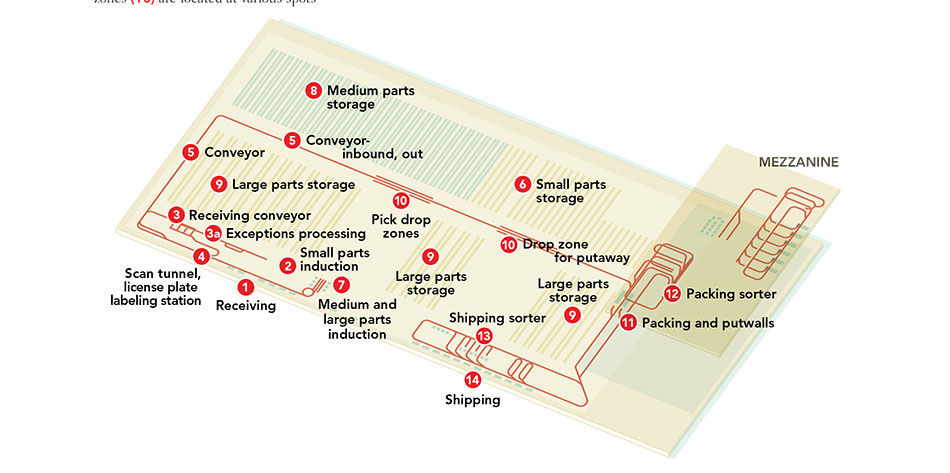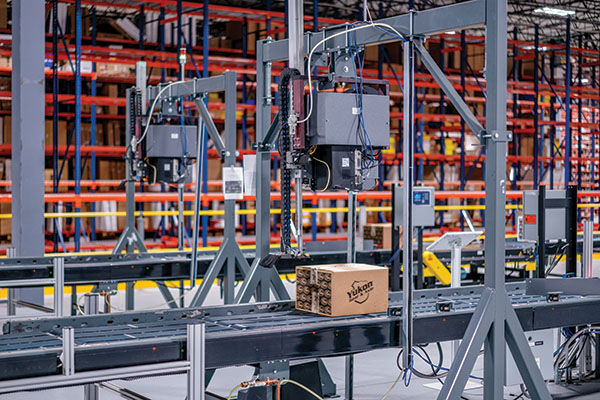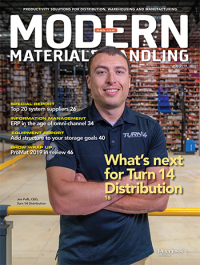Turn 14 Distribution: Putting automation to work
Turn 14 Distribution’s new DCs rely on a homegrown WMS, weighing and dimensioning, and disciplined process to speed deliveries to customers.
Turn 14 Distribution
Horsham, Pa.
Square Footage: 210,000 plus 30,000 square feet of mezzanine
Products Handled: Performance auto parts
Throughput: 10,000 pieces today with a capacity for 30,000 pieces per day
SKUs: There are 75,000 unique SKUs in the facility, 365,000 SKUs in the WMS system, with access to 1 million through partners
People/Shifts: 2 shifts at 16 hours a day, 6 days; Saturdays are covered by a fourday- a-week, 10-hour-a-day specialty shift.
Read the full editorial article on the systems in place at Turn 14 Distribution.
Turn 14 Distribution, a distributor of high-performance parts for automotive enthusiasts, went from one 52,000-square-foot distribution center to a network of three facilities measuring more than 200,000 square feet each and using identical systems.
Receiving and putaway into storage
The facility conducts two different receiving (1) processes: One for small parts measuring up to 10 inches and another for medium-sized parts (up to 36 inches) and large parts (up to 80 inches). Regardless of the size of the part, the Turn14 warehouse management system (WMS) prioritizes storage locations around the velocity of a part. The fastest movers are stored in the lower bays in the rack and pallet storage areas so they can be picked by an associate with a cart rather than one on an orderpicker since the picking process is faster on foot.
Small parts
Newly received product is inducted (2) onto a receiving conveyor (3) and sent to a six-sided scan tunnel and license plate labeling station (4), which reads the manufacturer’s label and weighs and dimensions the items. After a Turn 14 Distribution license plate label is placed on the product, it is sent to a lane where it is placed in a tote for storage. Totes are then conveyed (5) to the small parts storage area (6). Associates load their carts with items for putaway and are directed to a location by the system, where they are scanned into a storage location and are available to promise.
Medium and large parts
Larger parts are also inducted (7) on a receiving conveyor (and go through a scan tunnel). From there, they go to a sliding shoe sorter, which sorts them to storage areas designated for medium-sized parts (8) and large parts (9). For instance, storage racks in the large parts area have been modified to handle extra-long parts. Items are then scanned into a storage location.

Parts that cannot be identified are sent to an exceptions processing area along the receiving conveyor (3a).
Picking
The WMS has the ability to interleave tasks, directing the associate to the “smartest task,” or the one that makes the most sense based on the associate’s location and the needs of the facility. For instance, when an associate is done putting away inventory, the system may direct that associate to do cycle counting at one or more locations, or direct the associate to a pick location. In all, nine associates use orderpickers along with associates picking to carts. Pick drop zones (10) are located at various spots along the conveyor. When associates have picked items ready for packaging, they scan the license plate bar code label, scan a pick drop location and place the item on the conveyor system. Small items are first placed in a tote while non-conveyables are taken by lift truck to the packing area (11), including the putwall, under the packing sorter (12).
Packing and shipping
Items that can be shipped in their packaging are conveyed to a shoe sorter that diverts them to one of two print-and-apply lines capable of handling 20 packages a minute. The license plate label is scanned and the package passes over a scale to verify the weight before the label is applied. From there two other scanners scans the label and the license plate label before the outbound sorter (13) determines the right lane for shipping (14).
Packaging
Single line orders that require re-packing are sent to a traditional pack station where they are placed in a new box and labeled. From there, they go to the shoe sorter, which diverts them to the print-and-apply area, and from there to shipping.
Totes for multi-line orders are sent to a 40-foot-long putwall. Associates using ring scanners scan a tote. Items in the tote are then put into a shipping container in a cubby location. Once all of the items for an order have been placed in a container, it’s pushed onto a conveyor and sent to a manual fill line and then to an automatic sealer. From there, the order follows the same path to shipping as other orders.
Quality control
Regardless of the size of the part, if new merchandise isn’t recognized by the system, it’s conveyed to a manual inspection station. If inspectors can’t identify they product, they send a picture of the item to the accounting team to research and identify the item. This allows the part to keep moving to the shelves even before identification is complete.

Article Topics
Automation News & Resources
Beckhoff USA opens new office in Austin, Texas ASME Foundation wins grant for technical workforce development Walmart chooses Swisslog AS/RS and software for third milk processing facility Lucas Watson appointed CSO for Körber’s Parcel Logistics business in North America 60 Seconds with Bob Trebilcock, outgoing executive editor, Modern Materials Handling Kathleen Phelps to join FORTNA as chief financial officer Coles automates grocery distribution in Australia More AutomationLatest in Materials Handling
Beckhoff USA opens new office in Austin, Texas Manhattan Associates selects TeamViewer as partner for warehouse vision picking ASME Foundation wins grant for technical workforce development The (Not So) Secret Weapons: How Key Cabinets and Asset Management Lockers Are Changing Supply Chain Operations MODEX C-Suite Interview with Harold Vanasse: The perfect blend of automation and sustainability Consultant and industry leader John M. Hill passes on at age 86 Registration open for Pack Expo International 2024 More Materials HandlingAbout the Author
Subscribe to Materials Handling Magazine

Find out what the world's most innovative companies are doing to improve productivity in their plants and distribution centers.
Start your FREE subscription today.
April 2024 Modern Materials Handling

Latest Resources












